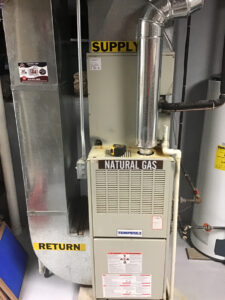 If you’re like many homeowners in our area, you are likely using a gas-powered furnace to heat your home each winter. Gas furnaces are great options for most homeowners around here. Today’s models have a much higher efficiency rating than those of even a decade ago, with the highest AFUE rating (Annual Fuel Utilization Ratio) being 98%.
If you’re like many homeowners in our area, you are likely using a gas-powered furnace to heat your home each winter. Gas furnaces are great options for most homeowners around here. Today’s models have a much higher efficiency rating than those of even a decade ago, with the highest AFUE rating (Annual Fuel Utilization Ratio) being 98%.
Efficiency is one thing though. It’s great, but what you really want is for your furnace to work safely. This isn’t to say that that they are inherently dangerous—they’re not. But if you don’t take care of your gas furnace properly—with routine annual maintenance and timely repairs, then the system can become dangerous.
The most common culprit of an unsafe furnace is a damaged heat exchanger. This is more likely to happen in an aging furnace versus one that’s under 7-10 years old but it’s still important to be aware of.
What Does the Heat Exchanger Do?
Great question! This part of your furnace isn’t simply “important” to the functionality of your furnace, but absolutely necessary for its functionality. The heat exchangers are where combustion gas collects in order to heat up the metal walls so that the air can pass over them, bringing heat into your home. So, the heat exchangers are the component of your furnace actually tasked with heating your home.
How Does This All Work?
What happens is that combustion gases enter the clamshell-shaped chambers of the heat exchangers. This combustion gas raises the temperature of the metal walls and then the blower fan pushes air over the metal chambers. That heat is then transferred into the air without the gases ever coming into contact with the air. So, the metal walls are the only thing that stands between the indoor air and combustion gas, such as carbon monoxide (CO).
The Problem with a Cracked Heat Exchanger
Throughout the years, natural wear and tear impacts your furnace system, and this includes the heat exchangers. Each time the heat exchangers heat up, their metal walls expand. They contract as they cool down. After doing this over and over for years, they become more prone to cracks.
These cracks we are talking about are microscopic—so small that they can’t be seen by the naked eye. However, when the heat exchangers get hot again and therefore expand, these cracks open up and that CO we mentioned above can leak out (and into your indoor air).
CO poisoning is very serious and nothing to take lightly. In fact, it contributes to hundreds of illnesses, and even fatalities, each year in the U.S. Allowing your gas furnace to continue running with a cracked heat exchanger increases the potential of this problem impacting the members of your household.
If you have an aging furnace (10-15+ years) and/or you haven’t had maintenance done on the system in over a year, it’s time to give us a call, so you can avoid this harmful problem.
For professional Joliet, IL furnace services, contact Comfort First Heating and Cooling Inc.—where we put your comfort first!

